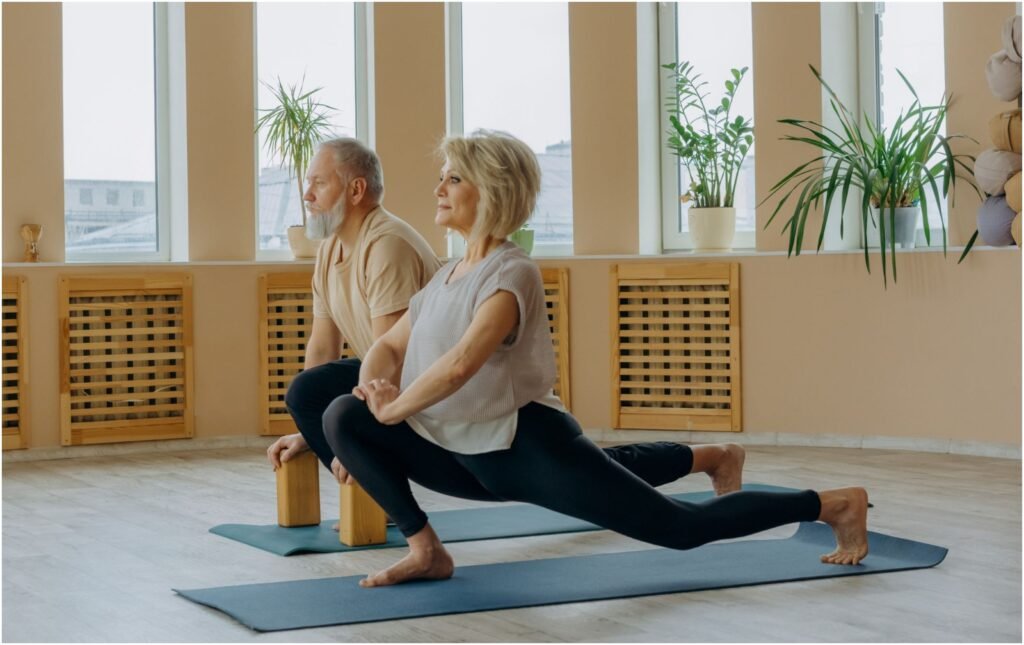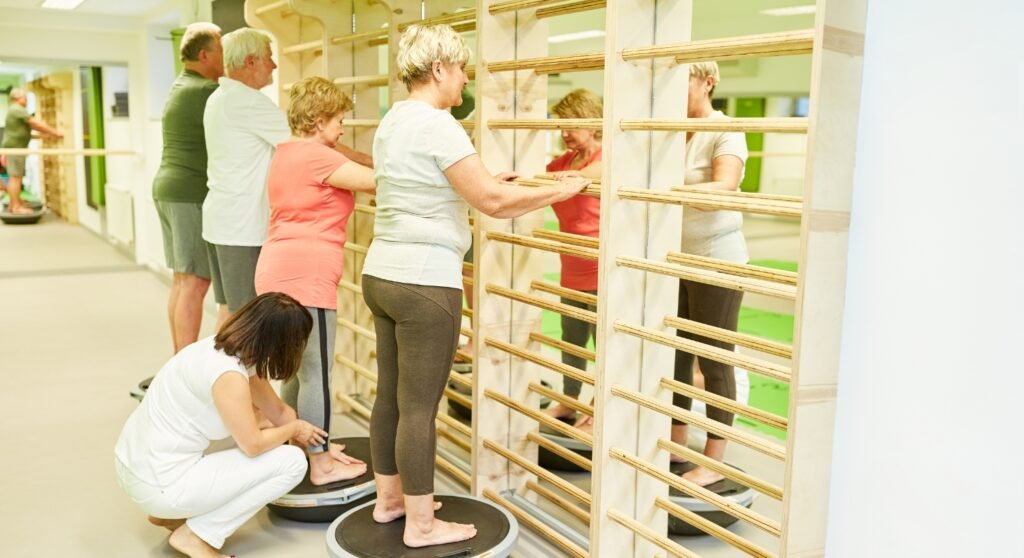Safe and Effective Weight Training for Seniors

Last Updated on June 27, 2025 by Julian Espinosa
Think weight training is just for younger generations? Think again! If you’re a senior looking to reclaim your strength, boost your confidence, and live more independently, weight training might be your secret weapon. Recent research shows that adults in their 60s, 70s, and beyond can experience remarkable gains in muscle strength and bone density—sometimes even outpacing younger individuals in their fitness improvements.
Weight training for seniors isn’t about building massive muscles or competing with twenty-somethings at the gym. It’s about empowering yourself to carry groceries without strain, climb stairs with confidence, and maintain the independence you’ve worked so hard to achieve. From strengthening bones to improving balance and reducing fall risk, the benefits extend far beyond the physical.
Whether you’re completely new to exercise or looking to restart your fitness journey, this comprehensive guide will show you how to approach weight training safely and effectively. You’ll discover the incredible health benefits, learn proper techniques, understand appropriate intensity levels, and get practical tips for getting started. We’ll also address common concerns and provide expert-backed recommendations for frequency, duration, and safety precautions.
Ready to discover how weight training can transform your golden years into your strongest years? Let’s explore how this powerful form of exercise can help you thrive at any age, building not just muscle, but confidence, independence, and vitality for years to come.
What Do You Need to Know About Weight Training for Seniors?
Weight training for seniors boosts health in big ways. It sharpens the mind and fights osteoporosis. This popular activity strengthens, balances, and improves overall health.If you think weight training is just for the young and athletic, it’s time to reconsider. Whether you’re 65 or 85, lifting weights isn’t about bulking up—it’s about living better, stronger, and more independently. Let’s explore the remarkable benefits that make weight training one of the most valuable investments seniors can make in their health and happiness.
Prefer to listen rather than read?
The Incredible Benefits of Weight Training for Seniors
Weight training offers seniors a pathway to enhanced vitality, improved health, and maintained independence. It’s not just exercise—it’s a powerful tool that can transform how you feel, move, and experience life in your retirement years.
Strengthening Muscles: Empowering Everyday Living
As we age, muscle mass naturally declines at a rate of 3-8% per decade after age 30, with the rate accelerating after 60. This process, called sarcopenia, can make everyday activities increasingly challenging. Weight training acts as a powerful countermeasure, helping you rebuild and maintain the strength needed for daily tasks.
Recent UCLA research found that mature adults can actually outpace younger individuals in strength gains, proving that age is no barrier to building muscle. With consistent training, you can regain the power to stand up from chairs without assistance, carry shopping bags with ease, and maintain your independence for years to come.
Boosting Bone Health: A Shield Against Fragility
Bone health becomes increasingly crucial as we age, with conditions like osteoporosis affecting millions of seniors. Weight training provides a unique solution by stimulating bone formation through the stress placed on bones during resistance exercises. Research from the National Institute on Aging has identified multiple ways strength training benefits mature adults, including maintaining muscle mass and improving mobility.
Every squat, lift, and press sends signals to your bones to become stronger and denser. This creates a protective armor against fractures and breaks, allowing you to continue living actively without the constant fear of injury.

Enhancing Flexibility and Mobility: Move with Ease
Fear of falling often becomes a limiting factor for many seniors, but weight training can be transformative. By strengthening your core muscles, improving proprioception, and enhancing overall stability, resistance training helps you navigate the world with renewed confidence.
Improved balance doesn’t just prevent falls—it opens up new possibilities. You’ll feel more comfortable on uneven surfaces, more confident in social settings, and more willing to engage in activities you might have avoided due to balance concerns.
Improving Balance and Coordination: Step Confidently
The benefits of weight training extend beyond the physical. Weight training for seniors not only enhances strength but can also boost motivation and self-confidence, creating a positive cycle of improved physical and mental health.
Regular resistance training has been linked to improved cognitive function, reduced symptoms of depression and anxiety, and enhanced overall quality of life. The sense of accomplishment from progressing in your workouts can be incredibly empowering at any age.

Guidelines for Proper Form and Technique
Embarking on a weight training journey as a senior requires attention to proper form, appropriate progression, and safety considerations. Here’s how to approach weight training in a way that maximizes benefits while minimizing risks.
Mastering Proper Form and Technique
Good form is your first line of defense against injury and your key to effective training. Focus on controlled movements, full range of motion where comfortable, and proper breathing techniques. Consider working with a qualified trainer initially to establish good habits from the start.
Starting Smart: Appropriate Intensity and Progression
Begin with lighter weights that allow you to complete 10-15 repetitions with good form. Fitness experts recommend working up to three sets of 10 to 15 repetitions for basic movements. As exercises become easier, gradually increase the weight rather than dramatically jumping to heavier loads.
Training Frequency and Duration
Current guidelines recommend doing strength-based activities at least two days a week. For seniors, 2-3 sessions per week with at least one day of rest between sessions is ideal. Keep sessions to 20-45 minutes, focusing on quality over quantity.
Rest for at least one full day (24 hours) between weight training sessions to allow proper recovery and muscle adaptation. This recovery time is crucial for seeing results and preventing overuse injuries.
Proper Warm-up and Cool-down Exercises
Proper warm-up and cool-down exercises are essential components of any weight training for seniors program. Warm-up exercises should be done prior to beginning weight training exercises and should be tailored to the particular movements that are to be performed.
This can include light cardio exercises such as jumping jacks, jogging, walking, and stretching to prepare the body for the physical demands of weight training for seniors. Dynamic exercises that focus on a range of motion can be beneficial to help increase the flow of blood to the muscles.

Cool-down exercises are an important part of any weight training routine. They should be done after the completion of the weight training exercises and should include static stretching, deep breathing, and light cardio exercises. Static stretching allows the body to slowly relax, reducing post-workout muscle tension.
Deep breathing helps to reduce blood pressure and slows down the heart rate. Light cardio exercises, such as walking, jogging, or cycling, can help to flush out lactic acid and other metabolic wastes from the body. Doing a cool-down can also help to reduce the risk of injury, decrease soreness, and improve recovery time.
Additionally, the cool-down period is a great opportunity to review your workout goals and reflect on the progress you made during the weight training.
Appropriate Intensity Levels
It is essential to adjust their intensity levels on weight training for seniors according to their physical abilities. Higher intensity levels should only be attempted by seniors who are physically fit, have no underlying health conditions, and have clearance from their doctor.
When it comes to weight training for seniors, higher intensity levels refer to the amount of effort and energy that is put into the exercise. This means that seniors should aim to push themselves to a greater level of intensity than they would for a regular workout. The intensity of the workout can be increased by increasing the amount of weight used or the number of sets and reps, or by performing the exercises at a faster pace.
While a lower intensity level means training with lighter weights, fewer repetitions, and longer rest times between sets when it comes to weight training for seniors. Lower-intensity training is designed to help seniors build strength and improve their physical abilities without putting extra strain or stress on their bodies.

Lower-intensity training can include the use of body weight exercises, such as squats and lunges, as well as the use of light weights or resistance bands. This type of training is also beneficial for those who are just starting out with a weight training program, or for those who are looking to maintain their current level of strength and maintain muscle.
Lower intensity levels should be used by seniors who have lower levels of physical fitness or who have underlying health conditions. If seniors are unsure of their ability levels, they should start with lower intensity levels and work their way up.
Seniors are especially vulnerable to injuries so it is important for them to start with lighter weights and work their way up gradually. If a senior is new to weight training, they should consider consulting a professional trainer to make sure that they are following the correct form and intensity level.

It is also important to listen to your body – if any exercise causes pain or discomfort, it is best to stop and check with your doctor. With the right precautions and a gradual approach, seniors can safely enjoy the benefits of weight training.
Training Frequency and Duration
Weight training for seniors is a great way to stay fit and healthy as they age. As with any physical activity, it’s important to take into account the frequency and duration of the activity. Frequency refers to how often seniors should be participating in weight training.
Generally, two to three days per week of weight training is recommended, with at least one day of rest in between. This will allow the body to rest and recover from the stress of strength training. Shorter duration weight training sessions, such as 15 to 20 minutes, can be just as beneficial as longer sessions, provided they are done with proper technique and intensity.
If a longer session is desired, it is best to break it up into shorter segments to ensure the proper technique is maintained and fatigue is avoided. It is also important to incorporate flexibility and cardio activities into a weight training for seniors program to ensure that all areas of physical fitness are addressed.
As seniors become increasingly adept at performing weight training exercises, the number of days per week they devote to the activity can increase to four or five – a great way to stay in shape! Start off with two or three days per week and build up from there.
When it comes to designing weight training for seniors, it is important to take certain factors into consideration. The total session duration should not exceed 45 minutes and each exercise should last no more than 15 minutes. This is to ensure the safety of the senior and to help limit the risk of injury.
It is also important to be aware of fatigue and exhaustion that can come with an aggro workout program. Prolonged physical activities can put a lot of strain on seniors and it can be particularly dangerous for those with existing medical conditions. Keeping the duration of the workout to 45 minutes or less helps minimize fatigue and exhaustion while still allowing seniors to get the exercise they need.
Rest periods between each exercise should be one to two minutes to help the body recover and prepare for the next exercise. This is important for both short-term and long-term performance. During the rest period, your body is able to re-energize and build strength, allowing you to perform the next exercise with higher intensity.

Taking rest periods helps prevent muscle fatigue, which can lead to injury. Furthermore, rest periods can help reduce stress and mental fatigue, allowing for better focus and a greater overall workout. Taking the time to rest between exercises can help you achieve the results you want from your workout.
Recommended Safety Precautions
It is important to take extra care when doing weight training for seniors so they can reap numerous health and fitness benefits. In order to safely reap these rewards, seniors are advised to use proper form, use weights that are appropriate for their level of fitness and ability, and take rest days so their bodies can recover and repair.
In addition to a well-rounded workout regimen, seniors should take the time to ensure that they are properly hydrated prior to and during any weight training. Adequate hydration is essential for good health, but it becomes even more important for seniors who are looking to stay active and fit.
Water helps to lubricate the joints and muscles, making weight exercises easier and helping to reduce the risk of injury or strain. Seniors should consider incorporating electrolyte drinks into their daily routine, as they can help replace any lost nutrients during exercise.
Additionally, it is important to use proper warm-up and cool-down exercises before and after any weight training session. Lastly, seniors should always consult a qualified professional before beginning any weight training program.
Wrapping It Up
Weight training for seniors represents more than just exercise—it’s an investment in your independence, health, and quality of life. With proper guidance, appropriate progression, and consistent effort, you can experience the transformative benefits of strength training regardless of your starting point.
Well, are you ready to start your very own weight training sessions? I’m sure you do! If this post helped you make an informed decision, you may also want to read our post about the free services for seniors.
Disclaimer
The content provided on MySeniors.World is for informational purposes only and is not intended as either financial or medical advice. Always consult a qualified professional before making any investment or health-related decisions.
Posts may contain affiliate links, meaning we earn a commission – at no additional cost to you, if you click through and make a purchase. Your support helps us continue providing valuable content.
FAQ Weight Training for Seniors
- Is it safe for seniors to start weight training if they’ve never done it before?
- Absolutely! It’s never too late to start weight training. Research shows that seniors can safely begin resistance training at any age with proper guidance. Start with bodyweight exercises and light weights, progress gradually, and always consult with your healthcare provider before beginning any new exercise program.
- How heavy should the weights be for seniors?
- Start with weights that allow you to complete 10-15 repetitions with good form while feeling challenged by the last few reps. This might be 1-3 pound dumbbells for some e xercises, or even bodyweight alone. Gradually increase weight as you get stronger—there’s no rush.
- Can weight training help with arthritis and joint pain?
- Yes, when done properly, weight training can actually help reduce arthritis symptoms by strengthening the muscles around joints, improving stability, and maintaining range of motion. However, always work with healthcare providers and qualified trainers to ensure exercises are appropriate for your specific condition.
- How quickly will I see results from weight training?
- Many seniors notice improvements in strength and energy within 4-6 weeks of consistent training. Visible muscle changes typically take 8-12 weeks. Remember, everyone progresses at their own pace, and consistency is more important than speed.
- Do I need to join a gym to do weight training?
- Not necessarily! While gyms offer equipment variety and professional guidance, you can start at home with resistance bands, light dumbbells, or even household items like water bottles. Many effective exercises use just your body weight.
- What if I have balance issues—can I still do weight training?
- Yes, but with modifications. Chair-based exercises, wall-supported movements, and seated weight training can all be excellent options. Working with a physical therapist or qualified trainer who understands balance issues can help you find safe, effective exercises.
- Should I do weight training if I have osteoporosis?
- Weight training can actually be beneficial for osteoporosis, as it helps stimulate bone growth. However, you’ll need to avoid certain movements (like forward bending) and work with healthcare providers to develop a safe program. Many exercises can be modified to be osteoporosis-friendly.
- How do I know if I’m overdoing it?
- Warning signs include persistent muscle soreness lasting more than 2-3 days, joint pain, extreme fatigue, or difficulty performing daily activities. Some muscle soreness is normal, but sharp pain, dizziness, or chest discomfort are signals to stop and consult a healthcare provider.
References
- UCLA Health. (2024, May 31). Weight training in old age can be beneficial. Retrieved from https://www.uclahealth.org/news/article/weight-training-old-age-can-be-beneficial
- National Institute on Aging. How can strength training build healthier bodies as we age? Retrieved from https://www.nia.nih.gov/news/how-can-strength-training-build-healthier-bodies-we-age
- Deseret News. (2024, January 31). Why elderly people should lift weights — new study shows encouraging benefits. Retrieved from https://www.deseret.com/2023/11/29/23981559/elderly-people-exercise-weights-health-benefits-strength/
- NPR Health Shots. (2024, March 11). Strength training boosts longevity, mood and metabolism as it builds muscle. Retrieved from https://www.npr.org/sections/health-shots/2024/03/11/1236791784/strength-resistance-weight-training-longevity-aging-heart-disease
- Verywell Fit. Weight Training for Seniors | Dumbbell Exercises. Retrieved from https://www.verywellfit.com/strength-training-for-seniors-3498669
- SilverSneakers. (2024, November 21). 5 Strength Training Exercises for Seniors. Retrieved from https://www.silversneakers.com/blog/strength-training-for-seniors-2/






Responses